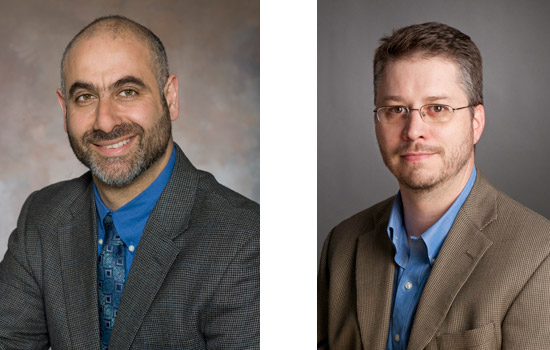Researchers develop advanced image processing
High-tech video processing algorithms differentiate static and moving objects for advanced intelligence processing and interpretation
Eli Saber and David Messinger
Rapid developments in satellite and sensor technologies have increased the availability of high-resolution, remotely sensed images faster than researchers can process and analyze the data manually.
Researchers at Rochester Institute of Technology are developing advanced intelligence processing technologies to handle those large volumes of data in a timely manner, and to effectively distinguish objects, scale, complexity and organization.
Eli Saber, professor of electrical and microelectronic engineering in RIT’s Kate Gleason College of Engineering, and David Messinger, associate research professor of imaging science in the university’s Chester F. Carlson Center for Imaging Science, were awarded two grants, totaling more than $1.1 million, from the Department of Defense to continue advancing this technology.
The first, “Hierarchical Representation of Remote Senses Multimodal Imagery” was awarded $576,042 to advance the foundation for object-based image analysis of remotely sensed images, and to explore the use of topological features to improve classification and detection results. The second grant, “Spatio-Temporal Segmentation of Full Motion Airborne Video Imagery,” was awarded $576, 043 and focuses on development of a segmentation methodology to differentiate the unique cues of moving and still objects derived from full motion video capture.
“It all comes down to efficiently handling large amounts of image data collected from satellites and video streams, which are not necessarily big images, but I can collect video for hours,” says Messinger, who also serves as the director of RIT’s Digital Imaging and Remote Sensing Laboratory. “You’d like to be able to download the data, have it go into a computer system and have it reduce that eight hours of video down to 20 minutes that somebody actually has to look at, just the highlights so they can process the information to make decisions.”
Both projects advance work done by researchers in the area of image segmentation, with this newest research focused on advanced video processing. Messinger and Saber’s project team will develop complex computer algorithms to promote a platform for intelligent computer processing. Computers interpret object information from images and video as a two-dimensional plane, unlike humans who understand an object’s three-dimensional aspects, says Saber.
“We struggle in doing the proper video segmentation intelligently,” he adds. “How do computers form this recognition that we as humans have understood for most of our lives? How do you get the computer to recognize images the same as humans would do it? It is a problem that is largely unsolved and difficult.”
The system the team is producing would be adaptable for identifying structures, objects of various sizes, shapes and timescales, says Messinger.
“It has to be flexible enough to capture all of that information in multiple spatial and temporal scales,” he says. “I want to be able to process it to extract information automatically, so I can make the process more efficient for the end user.”
Related articles:













